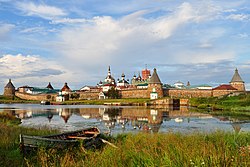You can help expand this article with text translated from the corresponding article in Russian. (August 2019) Click [show] for important translation instructions.
|
Солове́цкий монасты́рь | |
 | |
| Monastery information | |
|---|---|
| Order | Russian Orthodox Church |
| Established | 1436 |
| Disestablished | c. 1917 |
| Reestablished | 1990s |
| People | |
| Founder(s) | Zosimas of Solovki |
| Important associated figures | Herman of Solovki, Savvatiy |
| Site | |
| Location | Onega Bay, Solovetsky District, Arkhangelsk Oblast, Russia |
| Coordinates | 65°01′28″N 35°42′38″E / 65.02444°N 35.71056°E |
| Public access | Yes |
| Criteria | Cultural: iv |
| Reference | 632 |
| Inscription | 1992 (16th Session) |
The Solovetsky Monastery (Russian: Солове́цкий монасты́рь, IPA: [səlɐˈvʲɛtskʲɪj mənɐˈstɨrʲ]) is a fortified monastery located on the Solovetsky Islands in the White Sea in northern Russia. It was one of the largest Christian citadels in northern Russia before it was converted into a Soviet prison and labor camp in 1926 to 1939, and served as a prototype for the camps of the Gulag system. The monastery has experienced several major changes and military sieges. Its most important structures date from the 16th century, when Filip Kolychev was its hegumen (comparable to an abbot).